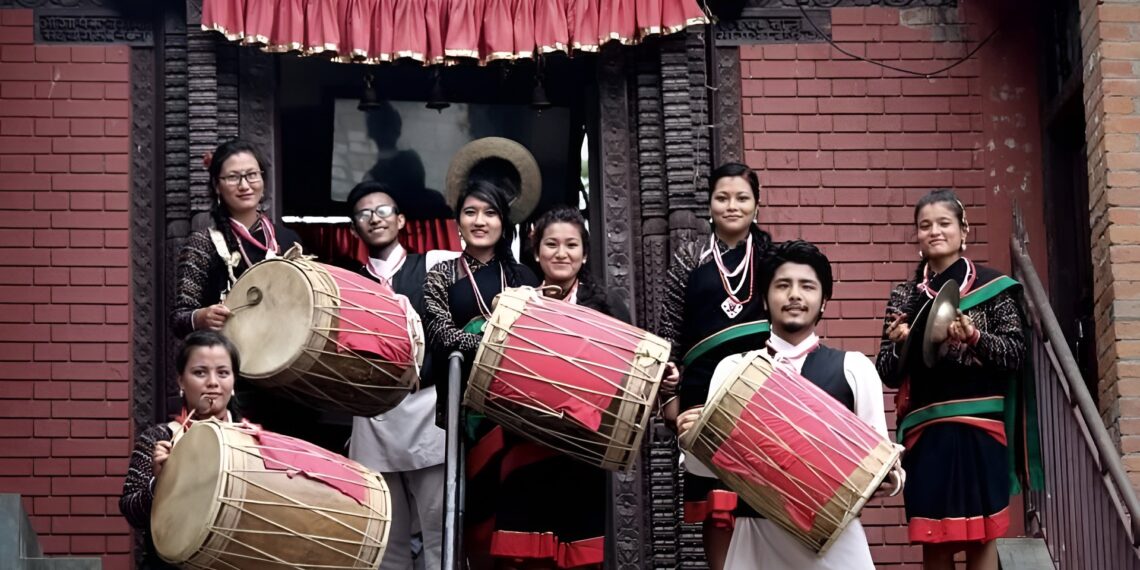Traditionally, in Dallachi, Dhime Baja (a cylindrical double-headed drum central to Newa culture) training was a secretive practice, hidden from onlookers and listeners alike. Though complete secrecy is impossible, the group maintains privacy and reverence by tenting the teaching area, honouring their tradition.
As the sun sets, a soft light envelops the ground of Dallachi. 30 children and young adults, aged eight to thirty, assemble with their instruments in hand. They arrive promptly at 6:00 PM, filled with eagerness to master the art of playing Dhime Baja.
The local group, Fayga Dhime Baja Khala, has taken on the responsibility of propagating this musical treasure, offering 4 to 5 months to teach.
“We are here to pass on our skills to the younger generation. Dhime is not just an instrument; it’s a vital part of our identity.” Roshan Shrestha, the president of Fayga Dhime Baja Khala, explains.
Newa, Music, and Dhime
The community of Newa plays music at every function, big and small, throughout the year, from Indra Jatra to Dashain and Tihar. And Dhime is the most popular and widespread musical instrument. “The rhythm of the ancient drum, serves as both a musical instrument and a cultural symbol, bridging the gap between generations,” Mr Shrestha adds
In the past, this instrument was taught only to a certain caste within the community. “I founded this group to provide equal opportunity for everyone to learn, inspired by the long wait I endured when I first wanted to learn,” remarked Mr. Shrestha
Though the name ‘Dhime’ is traditionally linked with the Jyapu caste of the Newa community, and remains synonymous with them, this musical instrument is no longer exclusive to Jyapu. Yet, the deep association between Dhime and Jyapu continues to honour their cultural legacy.
This drum is rather big compared to other drums; it is made of wood or metal, and both head covers are made of goatskin. It has a varied diameter of 40 to 50 inches and a length of 17 to 21 inches. There are two types of Dhime instruments: one is smaller, called “Dhaacha Dhime”, and one is bigger, called “Ma Dhime”. Dhime’s left side is played by hand, while the right side is played with a thin cane stick, typically curved at the end.
“We teach Baja free of cost here; any money we take goes for the management of the Baja. There’s very little government funding, to the point it’s negligible,” says Mr Shrestha.
The approximate price of Dhime Baja ranges between NPR 4,500 (35 USD) to NPR 14,000 (108 USD) depending on the size, quality, and sellers. “That’s one of the reasons why we are very selective of the students we take. We need someone who can contribute to continue the legacy through this training,” he adds.
Youth Engagement and Conservation
Nasala Shrestha, one of the enthusiastic students, shows a strong desire to save her culture. “Once I learn how to play this instrument, I will contribute towards preserving our tradition,” she notes. We may perform Dhime Baja to hold the festivals when we are sure that our culture does not die. Roshan Shrestha, one of the committed teachers, also speaks about the necessity to give these young musicians a large platform. “After they finish their lessons, we will then present them to the many cultural programmes. Such exposure also highlights their talent besides helping preserve our age-old traditions.”
By engaging the youth in learning Dhime Baja, Kathmandu not only fosters musical talent but also cultivates a sense of pride in their shared heritage.
As the night progresses, the rhythm of Dhime Baja creates an enchanting atmosphere. This reminds everyone that it is more than just a group of musicians rehearsing–a passionate revival of Newari culture. The art of playing Dhime Baja is still alive and well in Kathmandu. And each beat evokes emotions, reminding the people of all the value of cherishing and sharing these wonderful traditions.
Pratikshya Bhatta is a junior editor with Nepal Connect.





